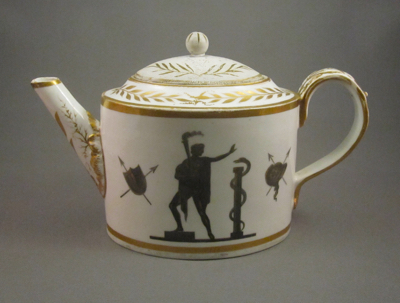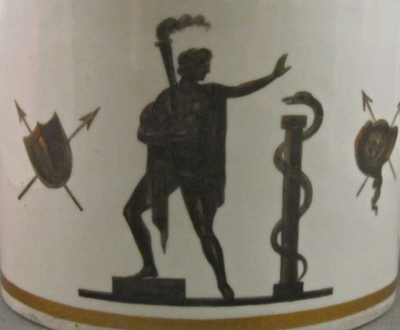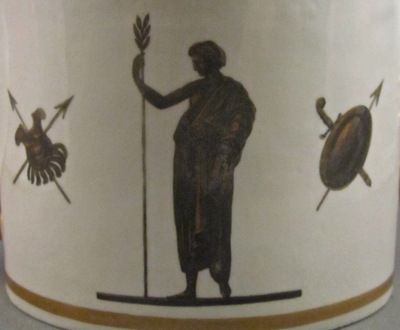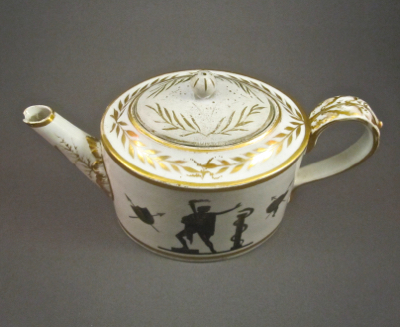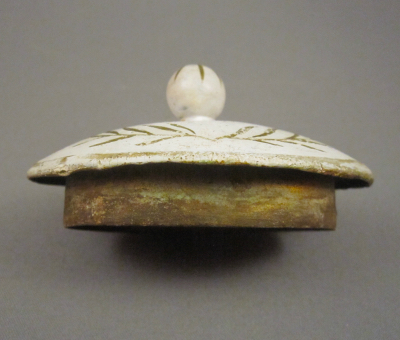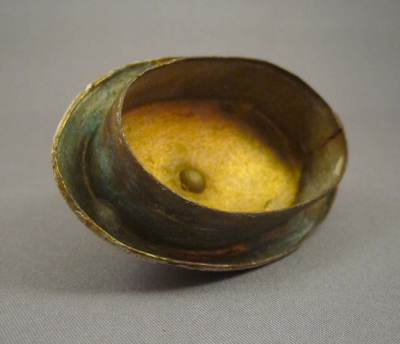Archive for the ‘teapot’ Category
Sunday, December 28th, 2014
This striking globular form teapot was made in China during the Qianlong period (1736-1795) for export to North America and Europe. It stands 5-1/4″ high and is decorated in cobalt underglaze with pavilions on islands in a lakeside setting.
After the original spout became damaged, the teapot was taken to a silversmith sometime in the 19th century, who replaced it with a silver Rococo style spout. I have seen many other examples of the same silver spout used on repaired teapots from the same period, so I imagine they were mass produced. In addition to the replacement spout, the broken handle has been riveted to the body and appears to be a later repair. By this point, the owner was taking no chances and chained the lid to the spout and handle to avoid further damage. On the underside is an etched signature Hood (?), but I am not sure if this was the owner of the teapot or the mender. I am hoping that it’s the latter and am on the hunt for more examples of signed ceramics.
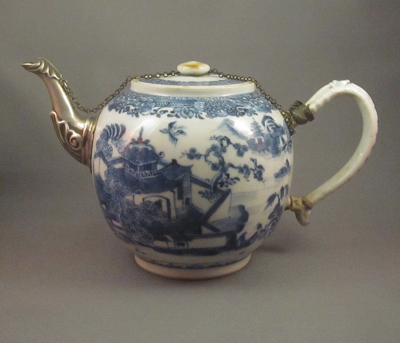

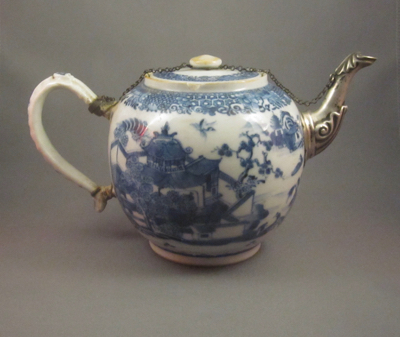
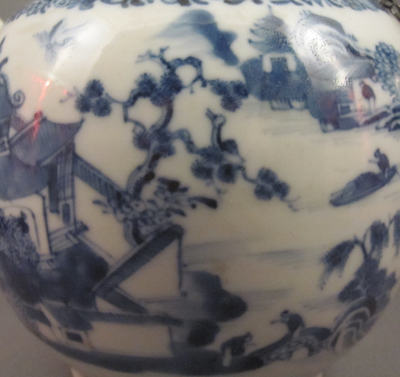
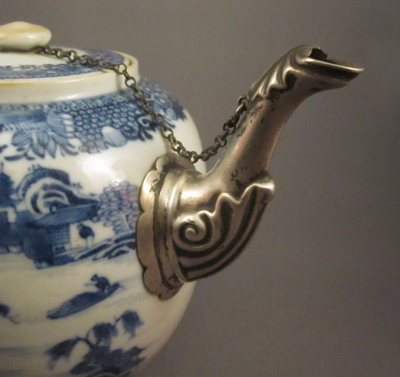
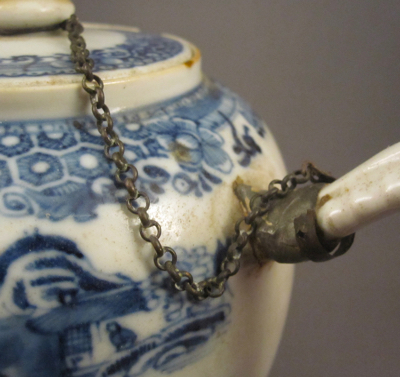
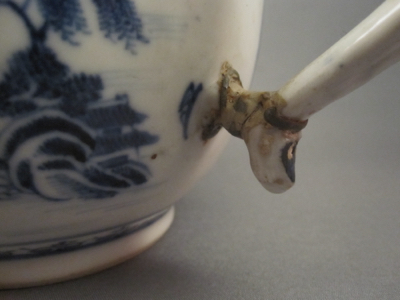
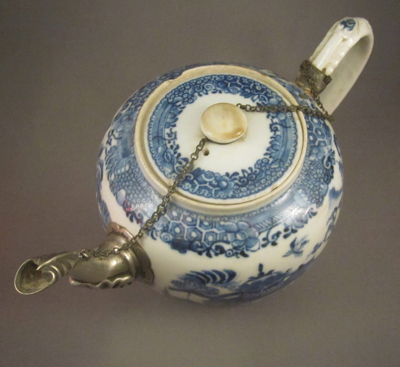
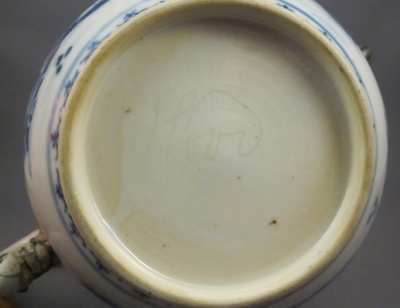
This teapot with similar form and decoration shows what the original spout on my teapot might have looked like.
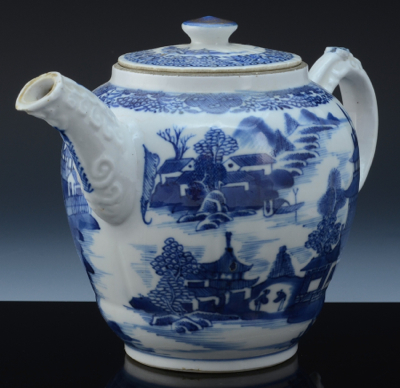
Photo courtesy of eBay
Tags:blue & white, Chinese, globular, metal spout, porcelain, silver
Posted in teapot | 2 Comments »
Sunday, December 21st, 2014
Wishing you all the best during the holiday season and for a healthy and Happy New Year!
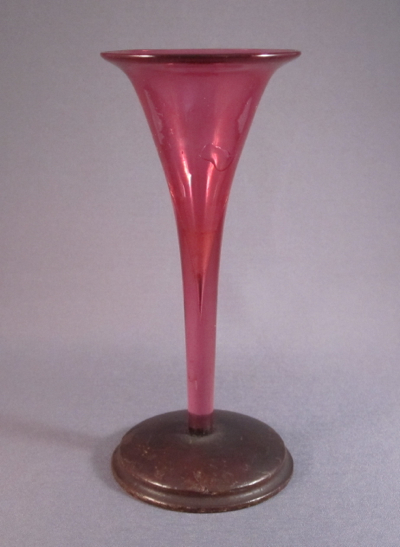
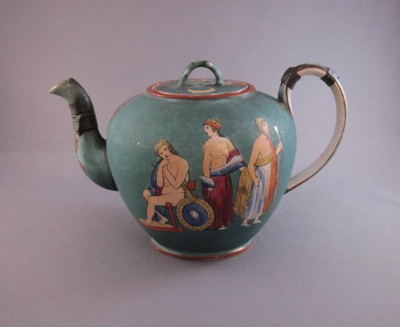
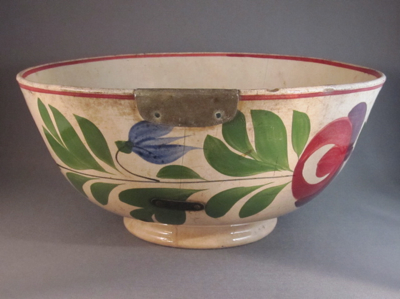
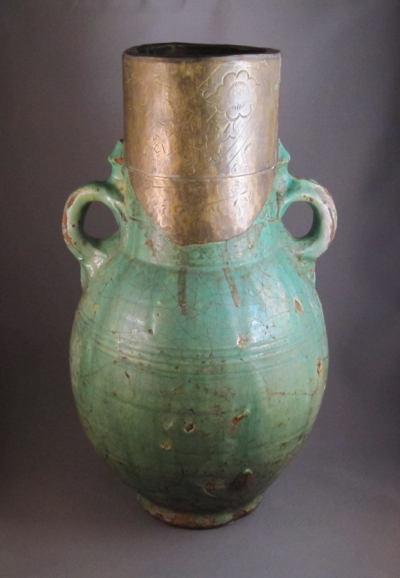
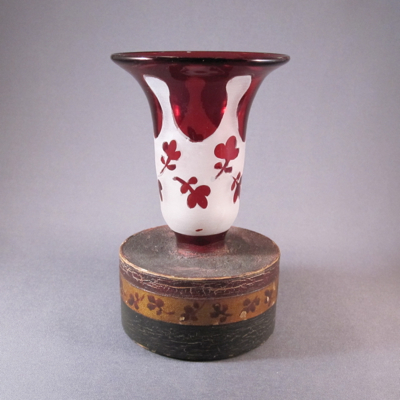
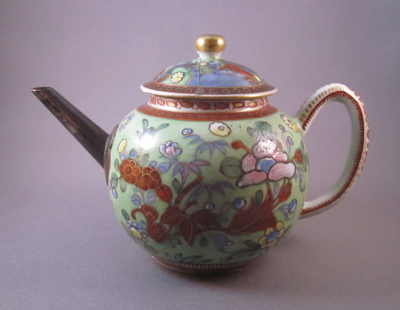
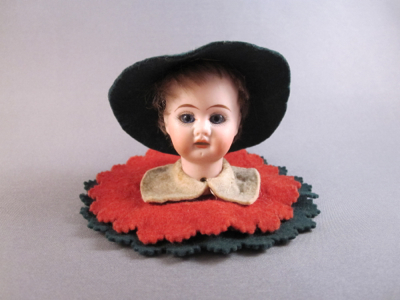
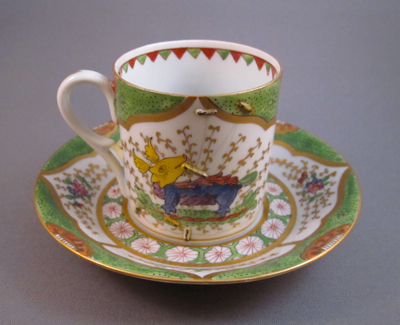
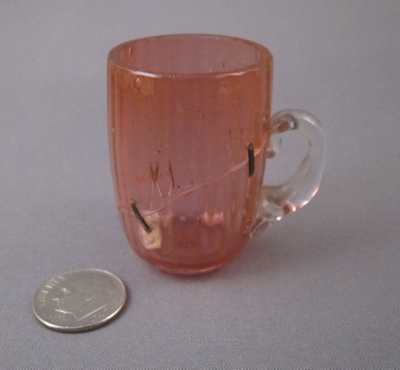
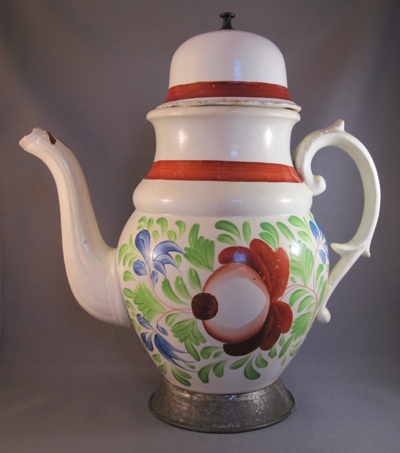
Tags:Chinese, clobbered, English, German, glass, globular, metal base, miniature, porcelain, pottery, silver, staples/rivets, wood base
Posted in bowl/dish, chocolate/coffee pot, cup/saucer, jug, plate/platter, teapot, toy, vase/vessel | 8 Comments »
Sunday, December 7th, 2014
This small earthenware pottery teapot with squat round shape was made in England during the first quarter of the 19th century. It has a black glaze, aka Jackfiend and Egyptian black, and stands 4-1/2″ high. Due to its small size it is known as both a Bachelor’s and a one-cup teapot. Some collectors and dealers believe that these tiny teapots are miniatures or part of a child’s tea set, but they are actually functioning teapots.
By now my readers know that the main reason I purchased this teapot is due to its early replacement handle. Made by a tinker in the 19th century, the workmanship is a bit crude, as is evident by the malaligned horizontal band laden with excess soldier and the twisted wire support around the base. But even a funny looking tiny teapot with a clunky metal repair is better than burning your fingers on a teapot with no handle.

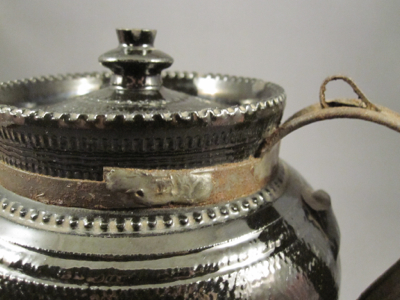
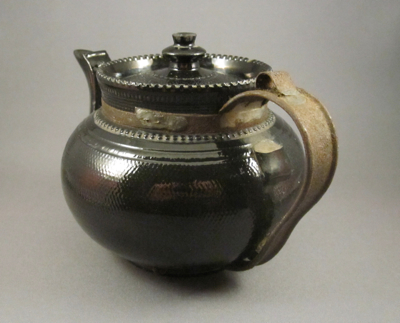
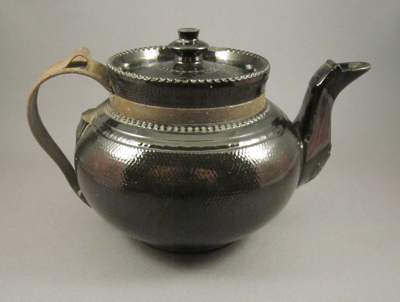
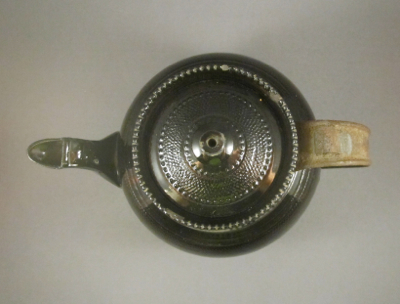
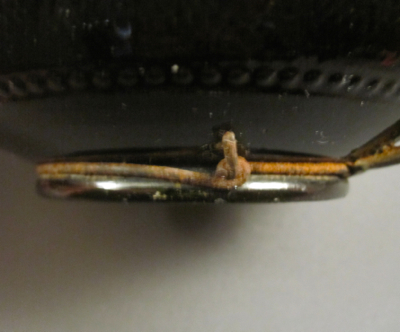
This teapot of similar form shows what the original handle on mine might have looked like.
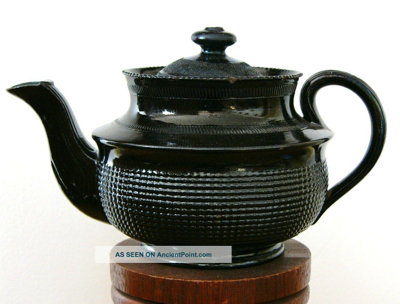
Photo courtesy of Ancient Point
Tags:basalt, English, metal spout, pottery, salt glaze
Posted in teapot | No Comments »
Sunday, November 16th, 2014
This delicate porcelain teapot was made in China for export to Europe during the Qianlong reign (1711-1799.) It is decorated “en grisaille”, a pencil style drawing in black, with touches of overglaze enamel of iron red and gilt. The European subject depicts a lady in her boudoir daintily clipping her toe nails as a male attendant watches nearby. This must have been a racy subject for the Chinese porcelain painters, raising more than a few eyebrows in the studio. Decoration of this kind was typically based on current popular engravings, reinterpreted by Chinese painters with sometimes amusing results.
When this 3-3/8″ high teapot dropped and broke in half, a china mender stapled it back together. I like how the bold metal staples and the darkened cracks add another layer of pattern to the decoration. The lid, possibly broken at the same time that the pot was damaged, has since gone missing. I am hoping to make a tin replacement cover for it one day.
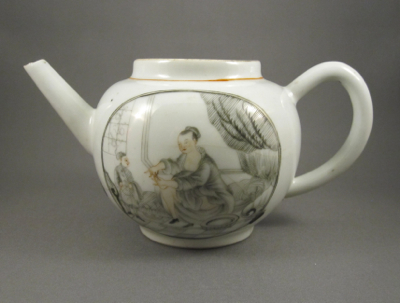

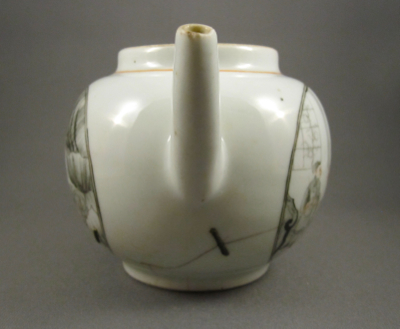
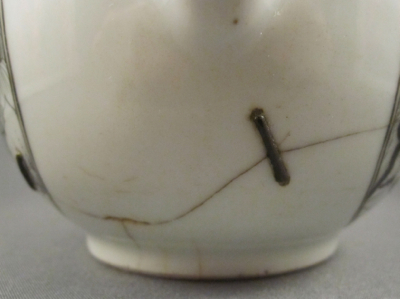

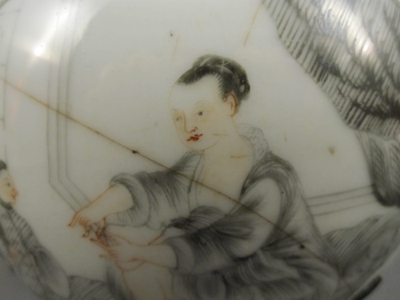
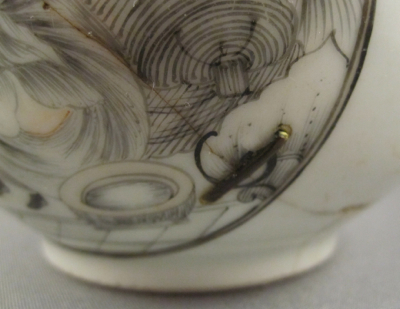
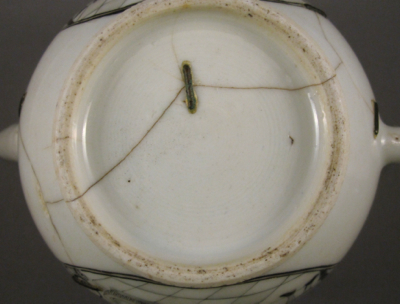
Tags:Chinese, porcelain, staples/rivets
Posted in teapot | 2 Comments »
Saturday, September 13th, 2014
This Qianlong period globular form teapot has a C shaped handle and an inlaid flat lid with round knob. It was made in China in the mid-1700s and stands 4-1/4″ tall and 7-3/4″ from handle to spout. The original blue underglaze decoration fell out of fashion shortly after it was made, as by the mid-1700s more “attractive colors” were the taste of the day. In order to keep up with the sudden demand for polychrome Chinese ceramics, factories in Europe took the unwanted blue and white decorated pieces and overpainted them with brightly colored enamels, often without regard for the original design beneath. This victim of clobbering, as it is also referred to, or Amsterdam Bont, when done in Holland, has been over decorated with the flower basket motif, one of the most popular designs.
The unusual form replacement silver spout appears to have been made by a skilled 18th century silversmith. It replaced a straight spout, but I think this replacement is much more interesting, and adds to the quirkiness of this twice-decorated teapot.
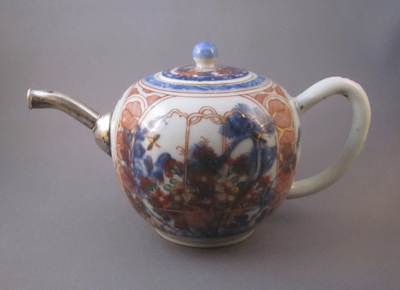


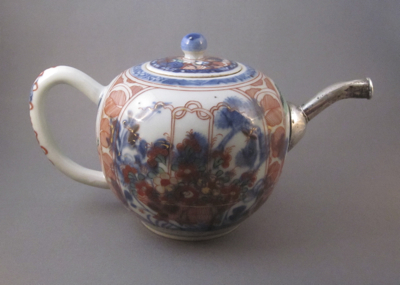
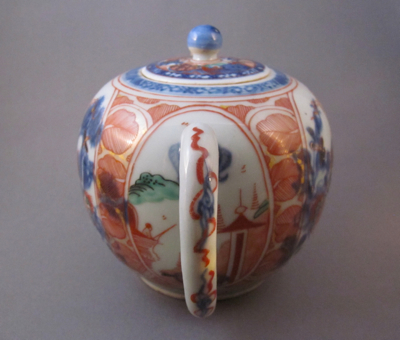
This teapot with similar form and decoration shows what the spout on my teapot might have looked like.
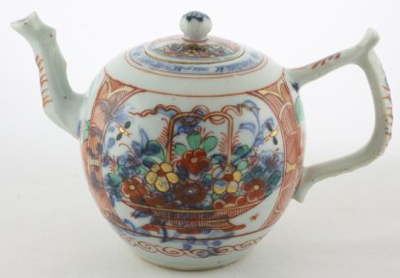
Photo courtesy of Pater Gratia Oriental Art
Tags:Chinese, clobbered, globular, metal spout, porcelain, Qianlong, silver
Posted in teapot | 1 Comment »
Saturday, August 9th, 2014
This large globular form porcelain teapot was made in China during the middle of the 18th century and has not one but two 19th century inventive repairs. It measures 6″ high and 9-1/2″ wide from handle to spout. Both sides have the same Mandarin decoration in the famille rose palette, depicting a family scene in a garden with trees and distant mountains.
But what makes this piece so special is the unusual shaped silver replacement spout with a heart shaped back plate and the overscaled wood replacement handle in silver mounts. I imagine the wood handle was intended for a larger teapot, but it might have been the only option available at the time of repair. I found this teapot in the UK and I have seen the same replacement spout on another teapot of the same period, also in the UK. Although most antiques collectors would rather have an example of this teapot in “perfect” condition, I much prefer the whimsy and uniqueness of this survivor with its quirky embellishments.
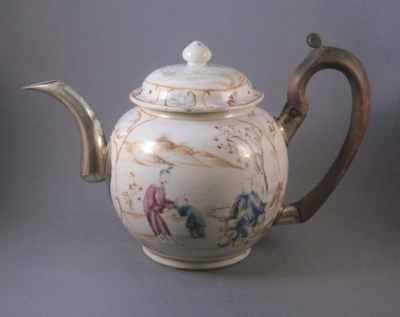
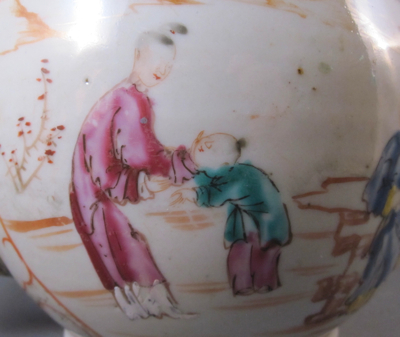

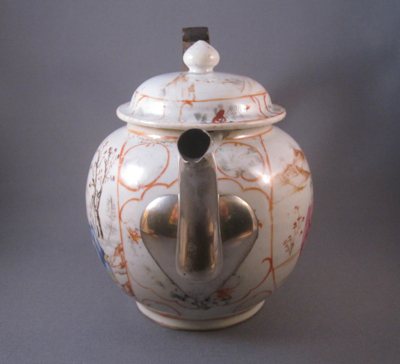
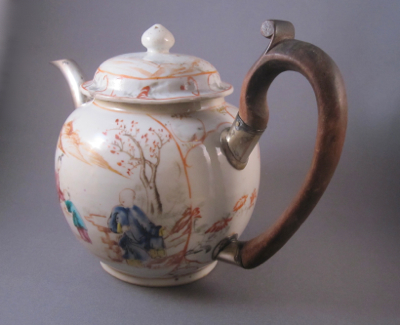
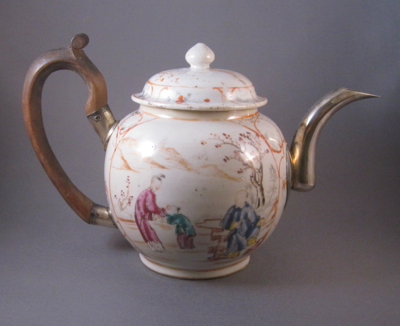
This teapot of similar form and decoration suggests what the original handle and spout on my teapot might have looked like.
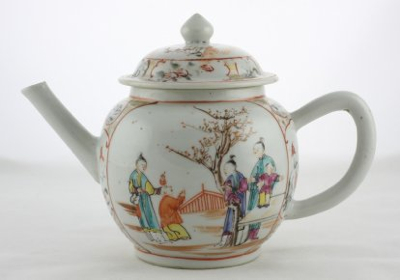
Photo courtesy of Pater Gratia Oriental Art
Tags:Chinese, Mandarin, metal spout, silver, wood handle
Posted in teapot | 8 Comments »
Sunday, July 20th, 2014
This handsome Castleford-style teapot with neoclassical design was made in England in the early 1800s. It is made of fine-grained unglazed black basalt stoneware with a hinged lid set in a scalloped rim and fastened with a metal pin. It measures 5-1/2″ tall and 8-3/4″ from handle to spout. Two different classical tableaux in detailed relief are on each paneled side, with acanthus leaves at the top and the bottom.
When this teapot was dropped over 150 years ago, the spout broke in two places and the knob came undone. Typically, fragile lids on teapots with this design snap off so I am surprised that this lid remains intact. A 19th century tinker repaired all of the broken bits by attaching two metal sleeves around the breaks in the spout and riveted on a new metal replacement knob. The metal repairs were originally painted black to blend in with the black basalt color of the pot, but time and age have peeled away the paint, leaving a pleasing patina to the metal. There is a later putty repair to a crack on the underside which is useless now, but I imagine it served its purpose at the time it was applied.
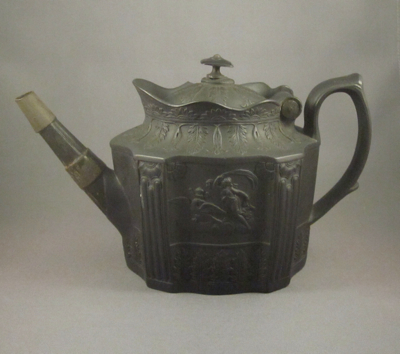
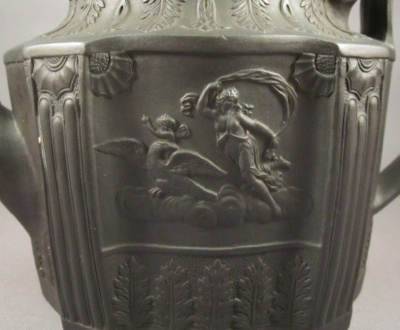

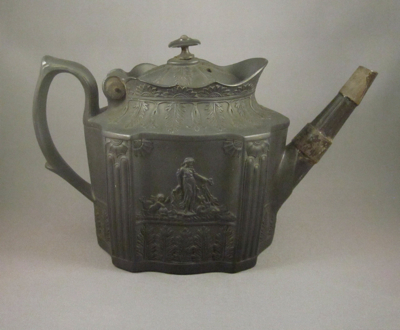
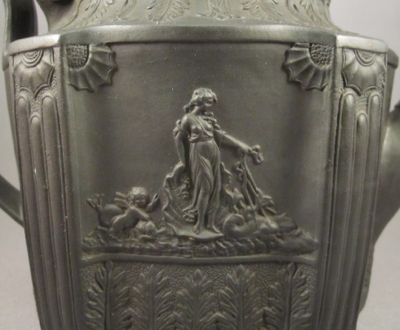
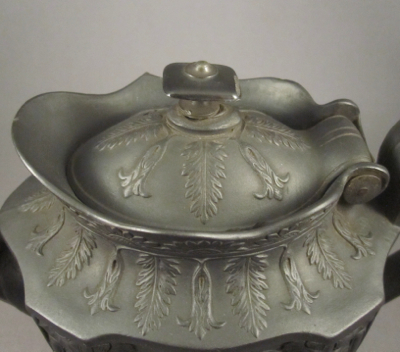
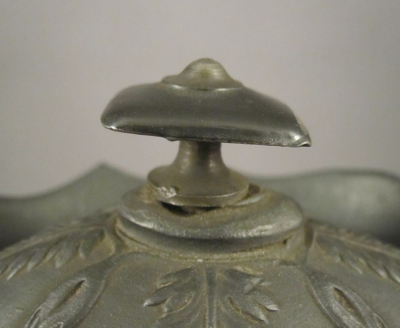
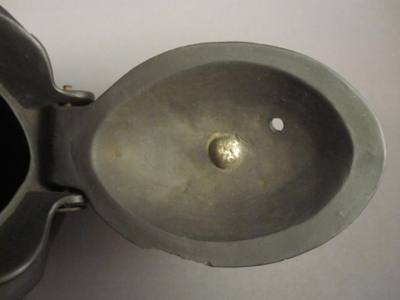

This example with nearly the same form, shows what the original spout and knob would have looked like on my teapot.
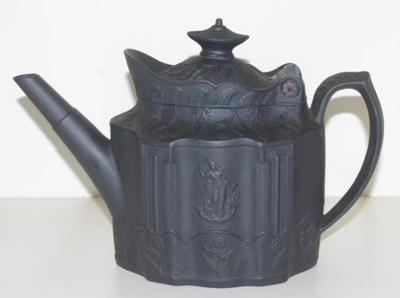
Photo courtesy of D. G. Barsby Antiques
Tags:basalt, English, metal spout, pottery, stoneware
Posted in teapot | No Comments »
Sunday, June 29th, 2014
This wee globular form teapot was made in China during the Kangxi period (1661 – 1722) and measures just 2-1/2″ high and 4-1/4″ from handle to spout. It has Famille Vert decoration of floral bouquets tied with ribbon in blue underglaze enamel, iron red and green washes, and gilt highlights. The domed cover, decorated with plum blossoms, has a tiny vent hole, just as its full-size counterpart would have. I believe that this was part of a larger tea set purchased for a child from a wealthy family, as only the upper class were able to afford imported Chinese porcelain.
Without seeing the coin to show the lilliputian size of the teapot, I doubt you would have guessed that this is a miniature. The exquisitely crafted metal replacement spout and rattan-covered bronze handle are superior to the more standard repairs seen on most other miniatures. It seems that someone truly appreciated the stellar repair work, as is evident by the teeth marks at the end of the spout. Perhaps this was just a child’s way of saying “This new spout tastes better than the old one. Thanks, and job well done!”
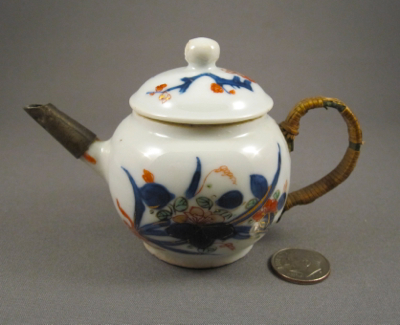
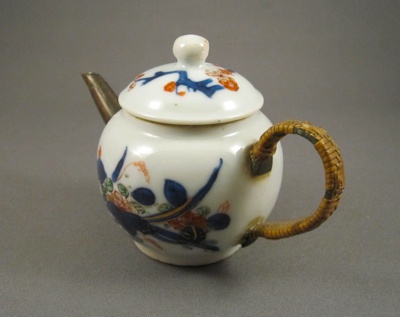
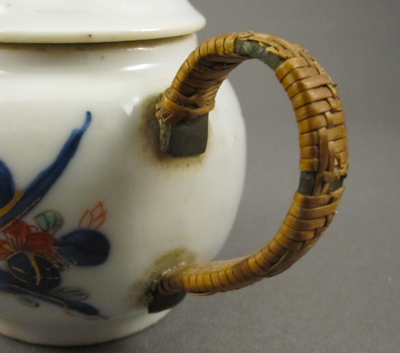
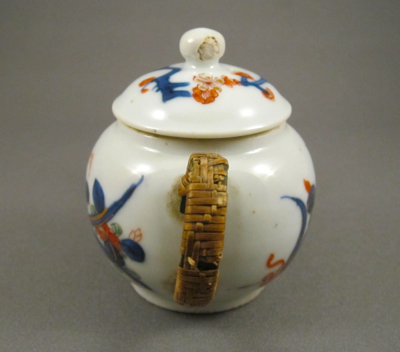
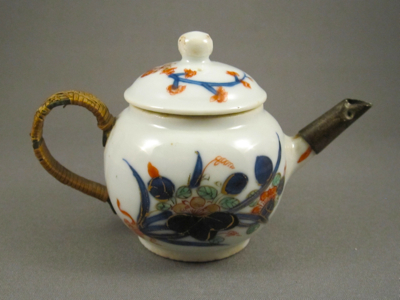
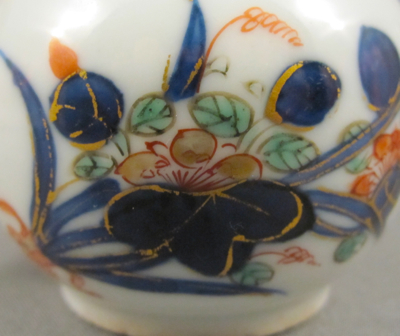
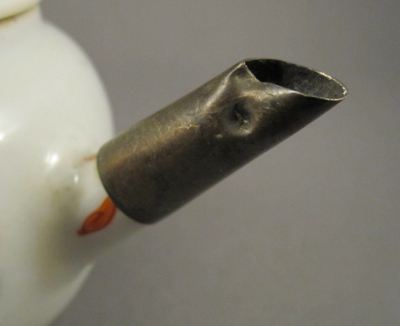
This nearly identical miniature still has its original handle and spout, but I think my teapot is the more interesting one of the pair.
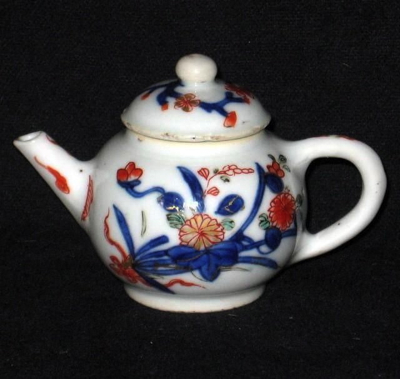
Photo courtesy of eBay
Tags:Chinese, metal handle, metal spout, miniature, rattan, silver
Posted in teapot | 3 Comments »
Saturday, June 7th, 2014
I purchased this little teapot thinking it was an example of Chinese Yixing ware with an elaborate early repair. It measures 7-1/2″ from spout to handle and is about 4″ high to top of finial. The shape appears to be typically Yixing but the brass lid, spout and horizontal strap, as well as the unusual incised mark on the underside, made me a bit suspicious. Now I feel the teapot dates from the latter part of the 19th century and was made in China for export to the Middle East, and that the mark on the base is Arabic. The brass spout and lid were most likely a part of the original design to help prolong the life of the teapot and not added to replace broken or missing parts. Learning to know the difference between a piece with an inventive repair and a piece that was designed with metal mounts can be a valuable, though sometimes a costly, lesson. Luckily, I did not pay very much for this “not-a-make-do” teapot.
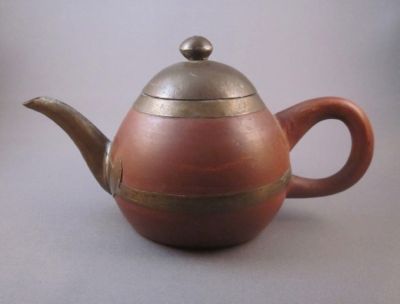



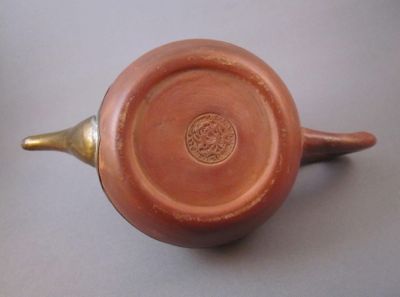

Tags:brass, Chinese, metal lid, metal spout, pottery, Yixing
Posted in teapot | 5 Comments »
